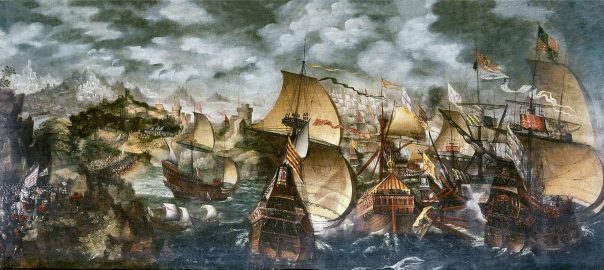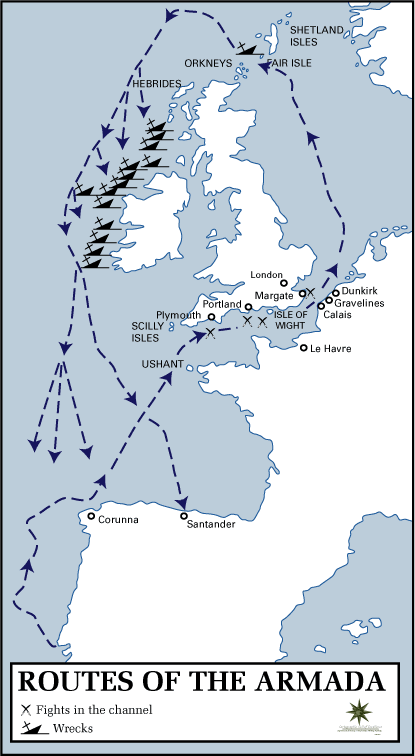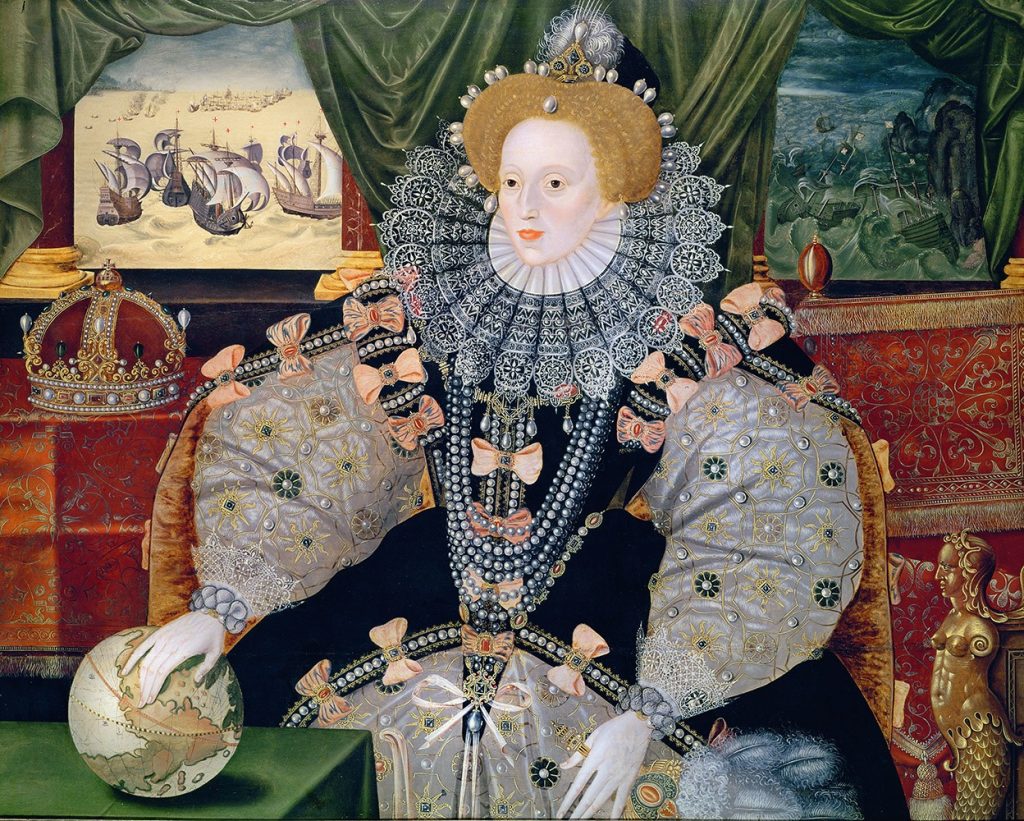Things of great impact were, of course, happening all around the world in 1588 CE (including in Portuguese Ceylon.) But since what I’m tracking here essentially the rise of the “West”, and the world into which it was rising, then today’s post has to keep its focus on events happening in the North Sea and the Bay of Biscay, which between them would determine the balance between the various large European powers that over the century to come would divide much of the world between them. (Scroll down for a brief report on the somewhat related developments that were unfolding in France in 1588.)
The Spanish Armada
In 1587, Francis Drake had “singed the King of Spain’s beard“, by destroying significant parts of the Spanish fleet both in Spanish ports and in Spanish-controlled ports in the New World. As Drake himself fully realized, Spain’s King Philip would be eager to retaliate– and as we saw earlier, in the case of the Ottoman fleet after Lepanto in 1571, back in those days, even if a large part of a country’s fleet was destroyed it did not take more than a year or two to rebuild it. In Philip’s case, a little less than a year. On April 25, 1588, the banner of his rebuilt Armada (navy) was blessed in a ceremony similar to that used before Lepanto and on May 25,
the Armada set sail from Lisbon and headed for the English Channel. The fleet was composed of 130 ships, 8,000 sailors and 18,000 soldiers, and bore 1,500 brass guns and 1,000 iron guns. The full body of the fleet took two days to leave port. It included 28 purpose-built warships, of which 20 were galleons, four were galleys and four were (Neapolitan) galleasses. The remaining heavy vessels were mostly armed carracks and hulks, along with 34 light ships.
In the Spanish Netherlands, 30,000 soldiers awaited the arrival of the Armada, the plan being to use the cover of the warships to convey the army on barges to a place near London. In all, 55,000 men were to have been mustered, a huge army for that time.
However, one vital thing that was missing was sound strategic leadership. Spain had at least one apparently very smart strategic thinker and planner of maritime campaigns, in the form of Admiral Álvaro de Bazán, 1st Marquess of Santa Cruz, who over the course of his 50-year career as a mariner had never been defeated. He had planned, executed, or helped to plan all those Spanish naval battles I’ve written about over the past 20-30 years. But on February 9, 1588, he died. Philip replaced him with the Duke of Medina Sidonia, an aristocrat without naval command experience . Not a smart appointment.
The whole English-WP page on the Spanish Armada is worth reading, but here are some highlights:
The aim was to overthrow Queen Elizabeth I and her establishment of Protestantism in England, to stop English interference in the Spanish Netherlands, and to stop the harm caused by English and Dutch privateering ships that disrupted Spanish interests in the Americas.
English ships sailed from Plymouth to attack the Armada and were faster and more manoeuvrable than the larger Spanish galleons, enabling them to fire on the Armada without loss as it sailed east off the south coast of England. The Armada could have anchored in The Solent between the Isle of Wight and the English mainland and occupied the Isle of Wight, but Medina Sidonia was under orders from King Philip II to meet up with the Duke of Parma’s forces in the Netherlands so England could be invaded by Parma’s soldiers and other soldiers carried in ships of the Armada.
The Duke of Parma was the guy who had been spearheading Spain’s brutal but often effective land campaigns against the Netherlands nationalists of the “United Provinces.” However, the UPs had also developed their own naval capability, which like the English one was fairly light, agile, and maneuverable.
The Armada entered the English Channel and anchored off Calais, awaiting the arrival of the Duke of Parma and his land-based fighters. The plan was that they would be conveyed to England in landing-barged, which would be protected by the Armada. But they were a few days late arriving. And while Medina Sidonia was awaiting some communication from the Duke of P, the English organized a night-time fireship attack against the Spanish fleet. Basically, that meant using old warships, filling them with brimstone and other combustible materials and just sending them unmanned to float in to the Spanish ships. And meantime, the Duke of P’s army was blockaded in its harbor in Dunkirk by a fleet of 30 Dutch “flyboats.” Then,
In the ensuing Battle of Gravelines, the Spanish fleet was further damaged and was in risk of running aground on the Dutch coast when the wind changed. The Armada, driven by southwest winds, withdrew north, with the English fleet harrying it up the east coast of England. On return to Spain round the north of Scotland and south around Ireland, the Armada was disrupted further by storms. Many ships were wrecked on the coasts of Scotland and Ireland and more than a third of the initial 130 ships failed to return.
(The banner image above is a stylized depiction of key elements of the Armada story.)
Meantime, there was an incident in early August when Elizabeth went to the eastern Thames Estuary port of Tilbury to review her forces, “arriving on horseback in ceremonial armour to imply to the militia she was prepared to lead them in the ensuing battle.” There, she delivered a very Churchillian speech, in which inter alia she said:
I know I have the body of a weak and feeble woman; but I have the heart and stomach of a king – and of a King of England too, and think foul scorn that Parma or Spain, or any prince of Europe, should dare to invade the borders of my realm; to which, rather than any dishonour should grow by me, I myself will take up arms – I myself will be your general, judge, and rewarder of every one of your virtues in the field.
Anyway, a combination of the winds and the mastery by the English and Dutch of some innovative naval-warfare technology and tactics brought about a defeat of King Philip’s plan for 1588.
The following year, Elizabeth and her advisors tried to nail down their victory by spurring a military-backed Portuguese secession movement against Philip, called the “Counter Armada.” But that expedition failed, too.
English-WP sums up the political effects of those two years of Armada and Counter Armada thus:
the Spanish failed to gain control of the English Channel, or stop the English intervention in Flanders or English privateer transatlantic raids. Although substantially weaker than the great armada sent in 1588, two more armadas were sent by Spain in 1596 and 1597, but both were once more scattered by storms. Nevertheless, through Philip II’s naval revival the English and Dutch ultimately failed to disrupt the various [Spanish] fleets of the Indies despite the great number of military personnel mobilised every year. Thus, Spain remained the predominant power in Europe for several decades.
The conflict wound down with diminishing military actions until a peace was agreed between the two powers on the signing of the Treaty of London in 1604.
In English national mythology, however, the defeat of the Spanish Armada marked a signal point in the emergence of a self-confident, defiant, and non- or anti-Catholic England.
Meanwhile, in France…
Remember how Philip of Spain had been plotting with the “Catholic League” in France to replace King Henry III, thought to be too conciliatory to the Hugenots and to the possibility of a succession by the openly pro-Hugenot Henry of Navarre? Well, it turns out Phil and his ambassador in Paris, Bernardino de Mendoza, had a pretty strong grasp of how to create Astroturf “popular movements”, even back then.
On May 12, 1588, Paris saw an outwardly spontaneous public uprising against Henry II, called the “Day of the Barricades” (in French: Journée des barricades.) But it turns out that uprising was in fact organized by something called the “Council of Sixteen”, representing the sixteen quartiers of Paris, which was led by the head of the Catholic League, and coordinated in detail by ambassador Mendoza…
Plus ca change, plus c’est la meme chose, huh?
The uprising had, moreover, been carefully timed to coincide with the great “victory” the Spanish had planned for their Armada.
The uprising spooked Henry III and caused him to flee the city. Then in July, Catholic League head the Duc de Guise managed to persuade Henri III to sign an agreement,
never to conclude a truce or peace with the “hérétiques“, to forbid public office to any who would not take a public oath of their Catholicité and never to leave the throne to a prince who was not Catholic; secret clauses [in the agreement] extended amnesty to all deeds of the Catholic League, accorded support to its troops and made over to the League additional fortified places de sécurité. Two weeks later the duc de Guise was named lieutenant général of the kingdom.
However, on December 23 and 24, Henry III had both the duc de Guise and his brother assassinated. The pro-Catholic backlash against that reportedly forced Henry III into a closer alliance with Henry of Navarre.
(This was all also connected with what had been going on between the English and the Spanish, of course.)



